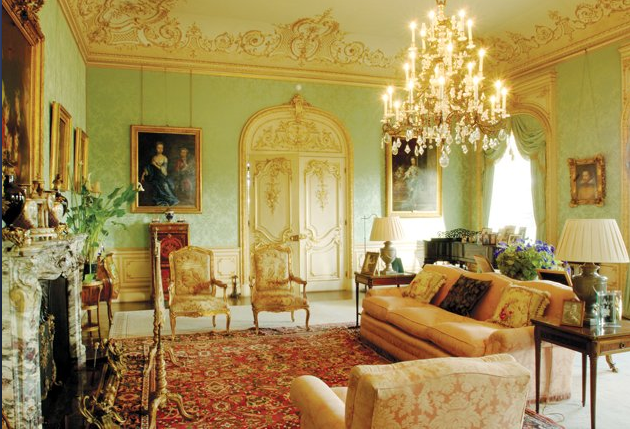
At the start of the Edwardian era, the use of electricity gradually made its way from public buildings to smart homes in cities and newly-built houses in the suburbs–though it took a while for this new method of power and lighting to reach the countryside. In the meantime, gas had finally banished candles (save when used to light the way to bed) from all but the humblest of houses and was supplemented by oil lamps. That said, housewives had multiple methods of lighting their houses at their disposal:
Gas
Advantages: (1) It is available for cookery, laundry work, and warming, in addition to lighting. (2) It saves time and trouble. (3) It is safer than lamps or candles, especially where there are children.
Disadvantages: (1) It is certainly the most unhealthy form of light, as it dries and heats the air; and one burner alone consumes as much oxygen as two adults. (2) The smallest escape will produce poisonous effects, and serious explosions may result from it. (3) The sulphurous vapour rapidly tarnishes silver, and injures plants, leather, and gilding.
There are three varieties of burners in common use:
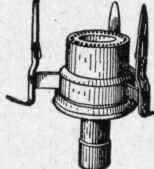 (1) The Argand (the most costly), which burns the gas from a ring of small holes, and which on an average equals thirty candles.
(1) The Argand (the most costly), which burns the gas from a ring of small holes, and which on an average equals thirty candles.
 (2) The Fishtail, or Union, which is formed by two small holes bored in the top of a closed tube, inclining towards each other, producing a flame as shown.
(2) The Fishtail, or Union, which is formed by two small holes bored in the top of a closed tube, inclining towards each other, producing a flame as shown.
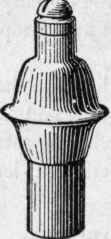 (3) The Batwing, which is formed by a long cut through a bulb on the end of a burner. This is durable and very easily cleaned, but from the spreading of the flame it is not so suitable where globes are used as it is for kitchens and passages.
(3) The Batwing, which is formed by a long cut through a bulb on the end of a burner. This is durable and very easily cleaned, but from the spreading of the flame it is not so suitable where globes are used as it is for kitchens and passages.
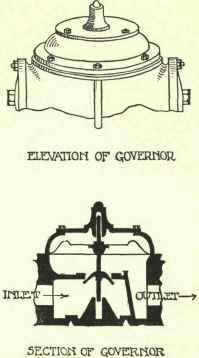
In many institutions economy in gas is secured by the use of a gas-governor, which acts as an automatic gas-tap, when fixed between the meter and the gas lights; closing and opening with every increase and decrease of pressure from the street mains. The cost varies from £1 15s. to £17, according to the size of the pipes to be controlled.
To Clean Burners: For this purpose an old toothbrush, or a corner of an old post-card should be used, not a wire, as this enlarges the holes and leads to the use of more gas. Grease may be removed by rubbing with paraffin, stale beer, or vinegar.
To Detect Leakages: If the smell causes suspicion of a leakage, the simplest way of proving this is by turning off every burner and then examining the meter. The exact spot, in an exposed pipe, may be ascertained by painting it with a mixture of soap and water, using a camel-hair brush, when bubbles will be seen forming round the leak.
To Stop a Leak: Paint the pipe with oil paint containing red lead. If the leak is in an ill-fitting bracket joint, it may be stopped by applying freely a mixture of two parts beeswax to one of tallow, used warm.
Incandescent Burners
An incandescent burner is equal to about 40 candles. The brightness is due to alternate oxidation and reduction of two parts carbon and three parts oxygen; it usually lasts from 1000 to 3000 hours, and then gradually loses its lighting powers. This loss is due to the presence of dust, which clogs the pores of the mantle and causes bits of silica to fuse on the fabric.
The most efficient form of incandescent light is that given by the “Block” burner, one alone being equal to three hundred candles, and costing one farthing per hour, using eight parts of air to one of gas. The mantle, which costs 1/3, is made of more durable materials than the ordinary varieties, and is mounted on a brass cap with a double nickel wire support, which ensures its comparative longevity. The inverted incandescent burners, which shed the light downward, and thus do not affect the ceilings, cost 6/6 each; the small inverted “Bijou” burners 4/6 each. These may be fixed to an ordinary bracket, either singly or in clusters. The “self-lighting” arrangement costs 9d. for each light to which it is attached. The pneumatic gas-lighting apparatus, costing 6/6 for each burner, is a great convenience, since by its means the gas may be switched on from the doorway in exactly the same way as the electric light.
Economy may also be ensured by turning off the gas from the meter at a given hour each night and also by day if no stoves are used. This prevents leakage through small escapes; but it is most important to see that all taps are turned off first, or when the gas is again turned on and lights applied explosions may result, if not lighted at once.
Acetylene Gas
is made from calcium carbide by the action of water on that compound; the residue is slacked lime. Acetylene comes off as a gas, great heat being evolved in the process.
A special burner is used of the fish-tail type, a large quantity of air being necessary to completely burn the gas. It gives out more heat and light per cubic foot than coal-gas, and hence is more economical. The cost of lighting by acetylene is about the same as coal gas, using ordinary burners, but twice as much when incandescent burners are used. It is less poisonous, but more explosive. The cost of plant for making and storing for a ten-light meter is about £7.0. It requires so little space that it can be accommodated in an outhouse six feet square.
Air gas is another illuminant well adapted for country houses; though it is now perhaps being superseded by petrol gas. It can be used for:
(a) Lighting.
(b) Enriching, i.e. increasing the heat and light-giving powers of coal-gas.
(c) To some extent in photography, as it shows up colours almost as clearly as daylight.
(d) Being easy to make, it is useful for heating and lighting remote schools and other buildings.
(e) With special burners it can be used as a source of heat for Bunsen’s and gas-stoves.
Oil
Paraffin or petroleum oil is apt to explode when heated above its flashing point, which in the case of ordinary oils is about 73° Fahr. In order to be secure from accident, it is wise never to buy an oil whose flashing point is under 100° Fahr.; this will cost lod. or 1 1d. per gallon. If bought in large quantities it is, of course, cheaper, but there is always risk in case of fire. Large amounts should be kept well corked in an outhouse or cellar. A lamp will always burn better when the oil is moderately warm; so that if the oil has been stored in a very cold place it is well to allow it to be in the kitchen a short time before filling the reservoirs.
The wick should be loosely plaited and should fit the burner. New wicks should be held to a candle for a minute to burn the top evenly, otherwise it is difficult to get them level. They give a better light and are less liable to smoke if, when new, they are steeped in vinegar, and dried before being placed in the burner. The required materials are a piece of American cloth, one duster for the stand, one for the chimney and globe, a lamp mop, old pair of gloves, soft tissue-paper, oil-filler, oil, and a little bristle brush.
Should a lamp be upset, and the oil set on fire, never throw water on it, as this only acts as an agent for floating the burning oil from place to place, and thus adds to the danger; the flames should be smothered by a heavy rug or mat, wet earth, or damp sand.
Lighting a Lamp: For this purpose a match or taper should be used—not paper, lest the ash fall on the wick and make the flame uneven. The light should not be turned on full for a minute, to allow of the gradual expansion by heat of the glass, when the cloudiness on the chimney—caused by the damp air inside—has passed off. It is a mistake to believe it an economy to keep a lamp turned down low, as quite as much oil is consumed, and an unpleasant smell is the only result.
Extinguishing a Lamp: Where there is no patent extinguishing arrangement it must be remembered that blowing down the chimney leads to pernicious results; the wick should be turned low, and one sharp puff be given across the top of the chimney. Another method is simply to lower the wick, and to place a circular piece of metal over the top of the chimney.
Electric Light
This, no doubt, will, in the not very remote future, supersede gas, just as gas, early in the nineteenth century, took the place, more or less, of candles and oil.
There are many advantages in its use as compared to other modes of illuminating.
1. It is cleaner than any other.
2. It gives no trouble, and is easily kept in order.
3. It is cooler.
4. The light is better.
5. It is safer than lamps or gas.
6. It is more economical (a) in that it can be switched off and on at once; (&) being more cleanly, it involves less labour, fewer new wall-papers, repainting, etc; and in some places is actually cheaper than gas.
7. It does not destroy gilding, tarnish silver, or injure plants. An electric meter is very similar to those used for measuring gas.
Where electric mains are in the street, it is not an expensive matter to have the house wired and connected. The average cost per light is 23/- to 25/-, which includes wiring, a plain pendant, fitting and shade. Electricity is sold by the unit, and one unit will light an eight-candle power lamp for thirty-five hours. The small glass bulbs, which vary in cost, become darkened after some months of use. When this is so, they should be renewed, as the light is consequently somewhat dimmed. The old bulbs cannot be cleaned, because if opened the carbon filament and the necessary vacuum would both be destroyed. To prevent waste of light (1) use suitable lamps for the voltage supplied (eight candle-power lamps for small rooms and passages); (2) switch-off at once after use. There is not likely to be any loss through leakage if the wiring is well done. There is also a minimum danger of fire now, provided the fittings comprise a fuze-box to cut-off the current received at too great pressure.
Candles
These are the most costly method of illuminating; but no light is so soft and restful to the eyes. Care should be taken in carrying a candlestick to hold it straight so as to avoid dropping grease about. Lighted candles should not be set in a draught, as they “gutter” and waste. They should be bought some time before use to harden. If wax candles become discoloured with keeping they should be gently rubbed with spirit of wine.
Before use all candles should be firmly fixed into the sockets of the candlesticks to avoid spilling the wax or burning crookedly. For this reason self-fitting candles with a graduated base are to be recommended—a small band of neatly folded paper may be used as a substitute, or if the candle be dipped into very hot water, it can then be moulded to fit the space exactly.
Night Lights: The best fat for their manufacture consists of drippings or small ends of candles, to which has been added some white wax (3d. per oz.) thinly shredded. These ingredients should be melted together, then poured into tin rings or bottoms of pillboxes. When cooling, but not solid, a wick made of twisted cotton should be put into the centre of each.
Manual of Household Work and Management (1913) by Annie Butterworth
Read more about Edwardian lighting at this post on the National Trust’s Treasure Hunt blog.

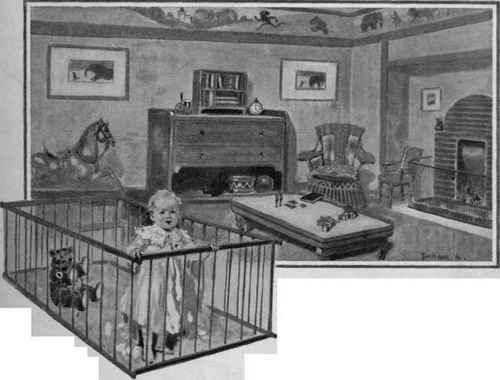
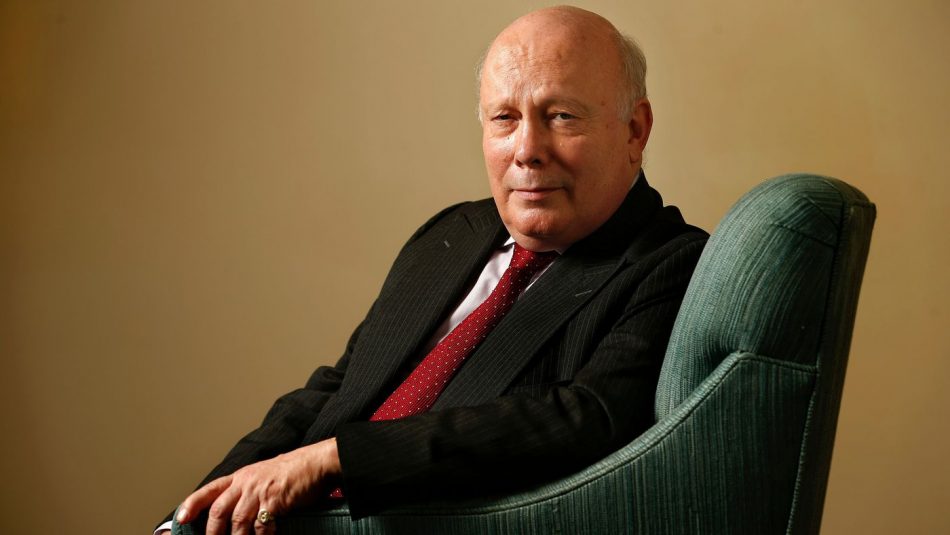
Thanks Evangeline, I love these fascinating snippets of Edwardian life.
You’re welcome, Felicity. I love finding them to post!
When I was in high school I was a docent in an historical home built in 1893. Their lamps had both gas and electric sockets, because the electricity plant only ran for 3 hours a night.
Three hours!? Wow.
Another fascinating post. These are the kinds of details that make for great texture in fiction (just knowing them, and then selecting the telling detail that could matter.) Love all the information your posts provide for one of the two eras that hold great interest for me.